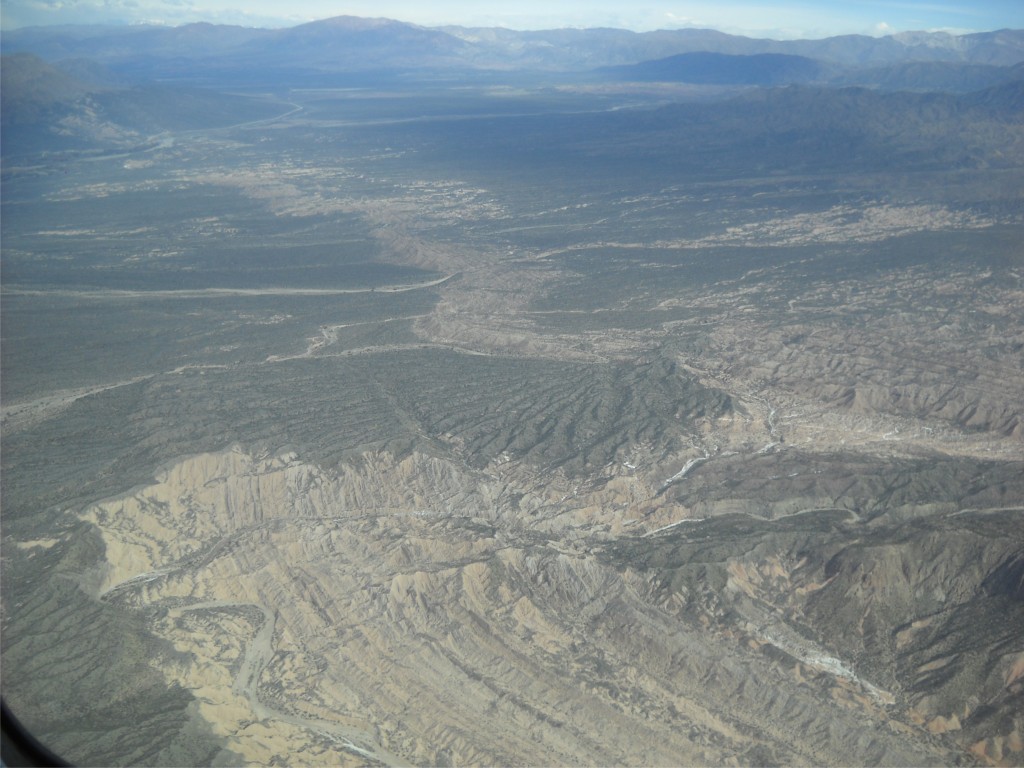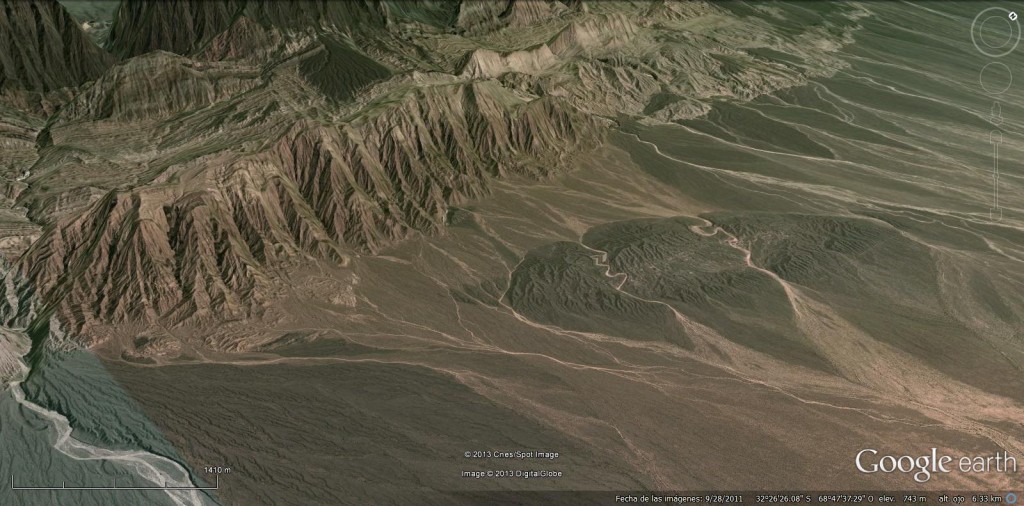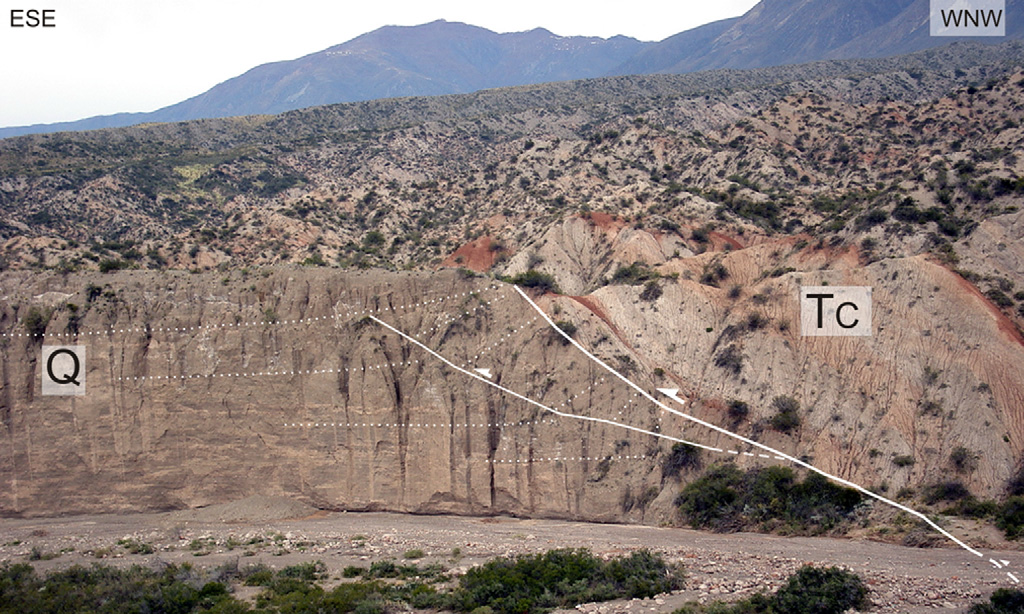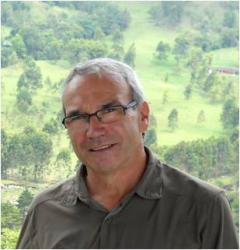Quaternary shortening at the Andean orogenic front (31°-33°s), Argentina: Current issues and challenges
Carlos Costa1, Emilio Ahumada1, Benjamin Brooks2, Andrew Meigs3, Lewis Owen4, Thomas Rockwell5, Lindsay Schoenbohm6, Carlos Gardini1, Héctor Cisneros1, Fabricio Vázquez1, 7
- Universidad Nacional de San Luis, Argentina. costa@unsl.edu.ar
- U.S. Geological Survey, USA
- Oregon State University, USA
- University of Cincinnati, USA
- San Diego State University, USA
- University of Toronto, Canada
- CONICET
Outstanding exposures, new data, and novel hypotheses developed during the last decade have turned the frontal deformation zone of the Andes between 31°S and 33°S (Fig. 1) into one of the most promising areas worldwide for improving the understanding on mountain building processes and seismic hazards related to thrust tectonics.
Because the Andes are relatively narrow in these latitudes, the geodetic signal in the backarc is dominated by the subduction zone locking process at the Chile trench. Nonetheless the geodetic analysis provides some useful constraints on the location and rates of modern backarc shortening, though not necessarily on the vergence. It is currently understood that backarc shortening occurs at rates of ~4-5mm/yr over a zone that is ~30km wide (across-strike) (Brooks et al., 2003; Kendrick et al., 2006). In the north (31°- 32°10° S) this would imply that the west-vergent, Eastern Precordilleran structures are the most likely to be active, while south of 32°10° S the east-vergent structures in the Southern Precordillera belt are likely to be most active (Fig. 1).

Figure 1: Main tectonic settings in the Precordillera region (Central western Argentina) between 31°S and 33°S, showing the major neotectonic faults and folds in white trace. WP, Western Precordillera; CP, Central Precordillera; EP, Eastern Precordillera; SP, Southern Precordillera; SF, Sierras Pampeans and foreland plains; FS: Flat slab subduction segment (in inset).The black cuadrangle corresponds to the Sierra de Las Peñas-Las Higueras area (see Fig. 2). 1, Pedernal Thrust System; 2, Las Higueras Thrust System; 3. Las Peñas Thrust System; 4, Cerro Salinas-Montecito Thrust System; 5, Mendoza river alluvial plain.
North of 32°10′ S, the Quaternary deformation is related to two opposing verging thrust systems, represented by the east-directed thrusts and by the west-directed thrusts of the Central and Eastern Precordillera thrusts, respectively (Ahumada and Costa 2009). Active structures are concentrated along the Eastern Precordillera, which are expressed by folding and faulting of the eastern piedmont. The rectilinear trace of these west-facing scarps combined with the bedding control of most fault surfaces has been interpreted as the result of secondary flexural-slip faulting (Figs. 2 and 3). Assuming that the prominent surface faulting resulted from distributed inter-bedding slip, these secondary faults can be interpreted as having less coseismic displacement than the main seismic source at depth. Therefore, the estimation of earthquake paleomagnitudes via empirical relationships likely underestimate the seismogenic potential of the primary sources.

Figure 2: Oblique aerial view of the La Laja fault, at the epicentral area of the 1944 seismic ruptures.

Figure 3: South-looking view of the La Rinconada fault scarp, a bedding-parallel structure at the Eastern Precordillera Piedmont (After Costa 2009a).
Trenches excavated across the La Laja and La Rinconada faults reveal numerous paleoearthquakes since the late Pleistocene, including both surface faulting and/or by blind thrust-related growth strata. These prehistoric coseismic displacements appear to be larger than those observed during the Mw 7.0 1944 San Juan earthquake. This suggests either larger individual earthquakes, or a different spatial distribution of slip in earlier events. Ongoing dating efforts (Hedrick et al., in press), using radiocarbon, optically stimulated luminescence and cosmogenic nuclide methods provide the first regional picture of the timing and size of past earthquakes, which will enable the magnitude of deformation for the regional seismic hazard to be quantified with greater confidence.

Figure 4: Aerial oblique view to the southwest of the bedding-parallel faulting affecting the El Mocho Quaternary alluvial, between Eastern and Central Precordillera in San Juan province).

Figure 5: Google Earth image of the Montecito anticline at the piedmont of the Las Peñas range (see Fig. 1). After Costa (2009b).
La Laja fault, because it ruptured in the Mw 7.0 1944 San Juan earthquake and occurs in the backlimb of the Villicum thrust sheet, has been the focus of considerable attention. Trenching, seismology, structural geology, detailed topographic and Quaternary mapping have been used to unravel the Late Pleistocene-Holocene deformation history of La Laja fault and the deformation of the Villicum thrust sheet (Rockwell et al., in review; Meigs et al., in review). In spite of this focused effort, however, the location and attitude of the main source for the 1944 earthquake is still a matter of controversy. Preliminary results suggest that the main bounding thrust of the Eastern Precordillera, the Villicum-Zonda-Pedernal fault, has undergone little displacement since the late Pleistocene. Active shortening is concentrated within the eastern piedmont of the Eastern Precordillera (break-back sequence?) and within the area between the Central and Eastern Precordillera (Fig. 4).

Figure 6: The Las Higueras thrust overriding Cenozoic rocks onto Quaternary alluvial deposits (After Ahumada and Costa 2009).
South of 32.25° S, Quaternary shortening is controlled by inversion earlier-formed structures during mesozoic rifting. Deformation due opposing thrust systems has resulted in two Y-shaped junctions (Fig. 1): At the northern junction, Quaternary shortening is being transferred between the west-directed (Pampean-type) thrusts of the Eastern Precordillera a west-directed system of Andean-type with thrusts of the Central-Southern Precordillera, through an antithetic linkage system, where several secondary structures contribute to accommodate deformation (Costa et al. 2006).

Figure 7: The Las Peñas thrust at the Río de Las peñas outlet, emplacing highly deformed Cenozoic rocks over undisturbed Quaternary alluvial layers (After Costa et al, in review).
At the southern junction between the Pampean and Precordilleran structures, the Montecito growth fold highlights interaction between the southern end of the Cerro Salinas thrust system and the Las Peñas thrust (32º25´S) (Fig. 5) (Costa et al. 2000; Costa 2009b; Vergés et al. 2007). The former structure corresponds to a Pampean-type thrust cored by a partially outcropping basement of the Sierras Pampeanas.
North of 31° S the Pampean-type thrusts were probably more active during the Neogene than the east-directed system Precordilleran structures. However, at the Southern Precordillera setting the Andean-type Las Higueras and Las Peñas thrusts (Figs. 6 and 7) likely accommodate the Quaternary shortening at higher rates than the Pampean-type thrusts (Pedernal and Salinas-Montecito thrusts system).
In the plains of the Mendoza province, possible neotectonic-related anomalies suggest that a recent east-ward shift of shortening reflects development of blind structures within the foreland. Features suggesting deformation in the foreland include: 1) a lack of modern and recent paleo-rivers flowing across the Alto del Desaguadero area, which stretches ~130 km N-S and ~70 km E–W; 2) the current north deflection of the Mendoza river along the border of this region; and 3) topographic inflection points and ~5 km-scale drainage deflections define the boundaries of this region. These facts could be probably due to the early landscape imprint of a rising basement structure in the Alto del Desaguadero region, similar to the Pie de Palo range to the north.
References
- Ahumada, E. and Costa, C. 2009. Antithetic linkage between oblique Quaternary thrusts at the Andean front, Argentine Precordillera. Journ. South Am. Earth Sci, doi:10.1016/j.jsames.2009.03.008
- Costa, C., 2009. Falla La Rinconada (AR-22). In: Proyecto Multinacional Andino Ed., Atlas de Deformaciones Cuaternarias de los Andes. SERNAGEOMIN, Publicación Geológica Multinacional N°7: 104-110.
- Costa, C., 2009. Anticlinal Montecito (AR-29). In: Proyecto Multinacional Andino Ed., Atlas de Deformaciones Cuaternarias de los Andes. SERNAGEOMIN, Publicación Geológica Multinacional N°7: 272-276.
- Costa, C., C. Gardini, H. Diederix and J. Cortés, 2000. The Andean thrust front at Sierra de Las Peñas, Mendoza, Argentina. Journal of South American Earth Sciences. Volumen 13: 287-292
- Costa, C., Audemard, F., Becerra, F., Lavenu, A., Machette, M. and París, G., 2006. An Overview of the Main Quaternary Deformation of South America. Revista Asociación Geológica Argentina, 61(4):461-479.
- Costa, C., Ahumada, E., Gardini, C., Vazquez, F. y Diederix, H., in review. Quaternary shortening at the orogenic front of the Central Andes of Argentina (32°15’-32°40’S): A field survey of the Las Peñas Thrust System. Geol. Soc. Sp. Publ.
- Hedrick, K., Owen, L., Rockwell, K., Meigs, A., Costa, C., Ahumada, E., Caffee, M. and Masana, E. Timing and nature of alluvial fan and strath terrace formation in the Eastern Precordillera of Argentina. Quaternary Sc. Reviews, in press.
- Meigs, A., Schultz-Fellenz, E., Ragona, D., Rockwell, T., Costa, C. y Ahumada, E., in review. Limits to paleoseismic event detection from fold growth strata. Journal of Geophysical Research.
- Rockwell, T., Ragona, D., Meigs, A., Owen, L., Costa, C. y Ahumada, E., In review. Inferring a thrust-related earthquake history from secondary faulting: A long rupture record of La Laja Fault, San Juan, Argentina. Bull. Seism. Soc. Am.



No Comments
No comments yet.